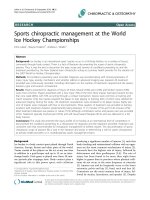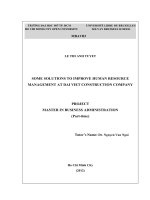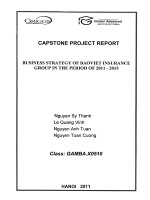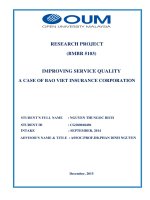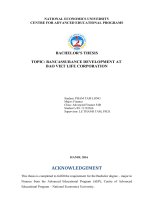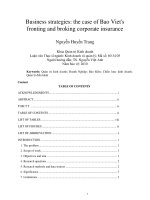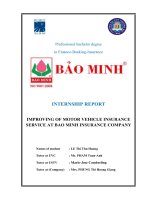distribution channels management at bao viet insurance corporation
Bạn đang xem bản rút gọn của tài liệu. Xem và tải ngay bản đầy đủ của tài liệu tại đây (326.36 KB, 64 trang )
ACKNOWLEDGEMENT
First of all, I would like to express my sincere thanks to PhD Pham
Khac Dung who enthusiastically guided and supervised the duration of my thesis
writing. The thesis was completed owing to his valuable instructions, correction and
comments.
Secondly, I would like to express my great thanks to all of the lecturers for
their interesting lectures during the course.
The thesis was also completed with the help from my leaders and colleagues
in Bao Viet Insurance Corporation.
Last but not least, I would like to say many thanks to my friends and family
for giving me encouragement and supports during my studying time and completion
of this thesis.
Hanoi, October 2013
TRUONG DUC ANH
TABLE OF CONTENTS
22
1
ABBREVIATION
AVI………… Association of Vietnamese Insurers
BAO MINH….Bao Minh Insurance Corporation
bln………… billion
BOD…………Board of Directors
BVI ………….Bao Viet Insurance Corporation
MOF…………Ministry of Finance
mln………… million
PA………… Personal Accidents
PJICO……… Petrolimex Insurance Corporation
PVI………… PetroVietnam Insurance Joint Stock Corporation
SMEs……… Small and Medium Enterprises
1
LIST OF TABLES
Table 2.1: Basic differences of services compared to goods………………………13
Table 3.1: Some business indicators of BVI in 2010-2012……………………… 25
Table 3.2: BVI’s staff qualification in 2012……………………………………….26
Table 3.3: The number of agents in the non-life insurance market in VN 2012… 42
Table 3.4: The number of agents and turnover through agents in 2010-2012…….42
Table 3.5: Turnover of agents in 2012 by lines of business……………………….43
Table 3.6: The average growth rate of premium turnover per agent …………… 44
LIST OF FIGURES
Figure 1.2: Research Process …………………………………………………… 7
Figure 2.1: Direct and indirect channels………………………………………… 12
Figure 3.1: Organizational structure of BVI……………………………………….24
Figure 3.2: BVI’s premium by lines of business………………………………… 27
Figure 3.3: Agent recruitment process at BVI…………………………………… 30
Figure 3.4: References for recruitment…………………………………………….33
Figure 3.5: Sources of recruiting………………………………………………… 34
Figure 3.6: Evaluation on business supporting activities of BVI………………….36
Figure 3.7: Evaluation on commission policy of BVI………………….………….37
Figure 3.8: Evaluation on training program of BVI……………………….………39
Figure 3.9: Evaluation on emulation programs of BVI……………………………41
EXECUTIVE SUMMARY
The effective management of the distribution system has been the key
management issue for any company to enhance its competitiveness as distribution
channel is considered as the bridge between producer/supplier and final user or
customer. However, the management of the distribution channels at BVI is still
ineffective while the competition in the non-life insurance market in Vietnam
increasingly become fierce following the international integration. Having
recognized of this, the objectives of this research are formulated as follows:
- To clarify the requirements for managing the distribution channels for non-
life insurane products.
- To analyze the management of the distribution channels for non-life
insurance products at BVI
- To suggest recommendations for BVI to improve the management of
distribution channels for non-life insurance products.
Basing on the theories on managing distribution channels together with
primary data and secondary data, the author has analyzed current situation of
managing distribution channels at BVI including selecting channel members,
motivating channel members and evaluating channel members to find out
shortcomings of managing distribution channels at BVI and causes of these
shortcomings. The findings are as follows:
- The selection of agents is still ineffective. Many agents, after being selected
and working, left BVI and moved to other insurance companies or found a new job
in other field.
- Turnover of agents mainly come from the two lines of businesses namely
motor vehicle insurance (59.77%) and personal accident insurance (20.83%) while
turnover from other lines of businesses is still low.
- The average growth rate in turnover per agent is on the downward trend
- The company has not yet put resources on supporting agents to sell
insurance products and loosened the creation of sales channels for agents.
55
- The evaluation of member channels is mainly based on turnover indicator
while ignoring the effectiveness and profit.
Basing on the development orientation of BVI for managing distribution
channel, the author has proposed recommendations for BVI to improve the
managing of distribution channel such as:
- Improving agent selection:
+ To set up selection standards more specifically for each position
+ BoD’s direct participation in recruitment
+ To refer to reliable sources of recruitment
- Improving agent motivation:
+ To work out policies to increase income of channel members
+ To effectively organize collective activities and movement
+ To have a proper remuneration and discipline regime
- Improving agent evaluation:
+ To better audit agent performance through such criteria as selling
capabilities, their attitudes and competition they faced and underwriting
effectiveness in order to have recommendations for corrective actions to reduce the
number of inadequate performances.
The author hopes that these recommendations will help BVI to sustain its
first largest position in the non-life insurance market and increase profits as well.
66
CHAPTER 1
INTRODUCTION
1.1. Rationale
Non-life insurance companies in Vietnam have been marketed various insurance
covers either directly or through different distribution channels including individual agents,
corporate agents and brokers. The insurance marketplace is undergoing a transformation
that may eventually lead to significant changes in how consumers purchase insurance
products. Besides, globalization has made competition in the non-life insurance market
become fierce with the establishment of foreign companies which have excellent insurance
knowledge, good selling and underwriting experiences as well as modern information
technology. This requires local companies to have proper management and organization of
distribution channels.
Established in 1965, Bao Viet Insurance Corporation (BVI) is the oldest and the first
largest non-life insurance company in the Vietnamese market. From its establishment, the
company has developed the biggest sales network of 67 member companies in 64
provinces across the country. The company provides main lines of businesses like personal
accidents & healthcare, marine hull and cargo, motor vehicle, and fire and engineering
insurance.
At present, the company is marketing its insurance products through the direct and indirect
distribution channels. Each distribution channel has its own advantages and disadvantages
during the distribution process. The direct channel is suitable with traditional customers
and corporate customers while the indirect channels are effective with individual and small
business household customers
Yet like other players in the market, managing distribution channels at BVI is still poor and
receives unsufficient investment. Turnover growth rate through these channels has been
declined in recent years and the number of agents has witnessed changes. BVI’s leadership
has recognized the importance of managing more effectively the distribution channels so
that the company can increase its growth rate and competitiveness and reach its
development targets in the context of fierce competition in the market. That’s why, I chose
the research topic “Distribution Channels Management at Bao Viet Insurance
Corporation” to find out achievements and shortcomings of managing distribution
77
channels in the company and to suggest recommendations to manage distribution channels
more effectively, contributing to the development of the company.
1.2. Research Objectives
This research is designed to:
- Clarify the requirements for managing the distribution channels for non-life
insurance products.
- Analyze the managing of the distribution channels for non-life insurance products
at BVI
- Suggest recommendations for BVI to improve the managing of distribution
channels for non-life insurance products
1.3. Research Questions
- What is the nature of distribution channels?
- What are the characteristics of non-life insurance?
- What were the concepts of managing distribution channel?
- What are the main factors affecting the managing of distribution channels?
- What are the requirements for managing the distribution channels for non-life insurance
products at BVI?
- What BVI can do to improve the managing of their distribution channels?
1.4. Research Methodology
1.4.1. Research Process:
Collecting secondary data:
books, magazines, market
reports
Requirements for
managing distribution
channel for non-life
insurance products at BVI
Recommendations
to improve the
managing of
distribution channel
for non-life
insurance products
at BVI
Collecting secondary data
about BVI: company’s reports,
strategies, website, etc.
88
Figure 1.2: Research Process
Source: Drawn by Author
1.4.2. Secondary data collection
The secondary data is sourced from the company’s reports, the market’s
reports, magazines, textbooks and the internet.
The data from textbooks and the internet provided the author with theories
on managing distribution channels and non-life insurance.
Information on the current situation of the non-life insurance market and
competitors was sourced from market reports, magazines and the internet.
BVI’s internal documents like company reports, development strategy, etc.
and market reports provided the author with information on the company’s turnover,
growth rate, market share, requirements for managing distribution channels for non-
life insurance products, etc.
1.4.3. Primary data collection
Colleting primary data is very essential because it reflects fully the needed
information for the research. The author collected primary data through the methods
of in-depth interviews and questionnaires.
(i) In-depth interview: The author interviewed the manager of the agent
managing department and collected information on the evaluation of the current
Current situation of
managing distribution
channels of non-life
insurance products at BVI
- In-depth interviews with
managers
- Questionnaires
99
situation of BVI’s agent management including achievements and shortcomings in
managing this channel and reasons for the shortcomings.
(ii) Survey:
- Purpose: the survey is conducted to get the agents’ evaluation of the
motivation and supports from BVI.
- Respondents: current agents of BVI
- Sample size: 400 agents.
- Sampling method: The author used the systematic sampling. Firstly, the
author had the list of agents in Hanoi sorted by name including more than
5000 agents. The author chose randomly one name and every 12 names the
author chose one for sampling.
- Questionnaire designing:
The questionnaire contains 13 questions.
The questionnaire is constructed mainly with multiple choice
questions.
The questionnaire is detailed in Appendix 2.
- Modes of data collection: email.
- Implementation: 400 questionnaires were sent to 400 agents in Hanoi. Yet
only 103 questionnaires were returned, accounting for 26% of the sample.
1.4.4. Data analysis
Regarding the survey data, the author uses Microsoft Excel software to
analyze the information.
The in-depth interview will provide themes for evaluating current situation of
managing distribution channel at BVI.
The secondary data is used to calculate some indicators presenting the current
performance of BVI as well as its position in the non-life insurance market.
1.5. Research Scope
- Research objects: The thesis focused on analyzing the managing of the
distributions channels at BVI that includes selecting channel members, motivating
channel members and evaluating channel members. Because of limited time, the
author focused on agent distribution channel only.
- Geographical scope: The survey will be conducted in Hanoi.
1010
- Timing:
Primary data was collected for the period of 3 months from June 2013 to August
2013.
Secondary data was collected for the period from 2010-2012.
1.6. Thesis Structure
The thesis is divided into four chapters as follows:
• Chapter 1 : Introduction
• Chapter 2 : Theoretical background on managing distribution channels for
non-life insurance products
• Chapter 3 : Current situation of managing distribution channel at BVI
• Chapter 4 : Solutions to improve the managing of distribution channel at
BVI
1111
CHAPTER 2
THEORETICAL BACKGROUND
ON MANAGING DISTRIBUTION CHANNELS FOR NON-
LIFE INSURANCE PRODUCTS
2.1. Distribution channels and non-life insurance products
2.1.1. Nature of distribution channel
Distribution channel is a flexible method that helps a company to implement
the same business objective or a bridge connecting the producer to consumer. There
are many different ways to define what distribution channel is.
In a general way, distribution channel is “path” or “pipeline” through which
goods and services flow in one direction (from vendors to consumers), the
payments generated from them flow in the opposite direction (from consumers to
vendors). A distribution channel can be as short as being direct from the vendor to
the consumer or may include several inter -connected (usually independent or
mutually dependent) intermediaries such as wholesalers, distributors, agents,
retailers, etc. Each intermediary receives the item at one pricing point and moves it
to the next higher pricing point until it reaches the final buyer.
( -channel.html)
The above is the general definition of distribution channel. However, it
differs as of the types of products and services provided by the vendors.
Furthermore, it differs as of the characteristics each product or service possesses.
Additionally, how long or short the distribution channel is depends on the
types of products and services and the way distribution channel is organized, i.e. the
distribution strategy of vendors.
There are two reasons that a company’s distribution decision is critical to its
success according to Philip Kotler, 2005 in “Principles of Marketing An Asian
Perspective”
1212
Firstly, it will affect all marketing decisions. How are the trainings needed or
how to manage motivation activities effectively and how to support its distribution
channels. Whether a company develops or acquires certain new products may
depend on how well those products fit the capabilities of its channel members
Secondly, establishing a distribution channel is to build long-term
commitments to other firms involving business to business relations and hence is
not easy or as flexible to change as other marketing decision.
Moreover, using distribution channel will bring greater efficiency to target
market. Through their contacts, experience, specialization and scale of operation,
intermediaries offer the firm more than it can achieve on its own. In making service
available to customers, distribution channels add value by bridging the major time,
place and possession gaps that separate services from those who would use them.
The main function of a distribution channel is to provide a link between
production and consumption. It fills the gap of places, time from producers to
consumers. Organizations that form any particular distribution channel perform
many key functions as follows:
- Information: Gathering and distributing market research and intelligence –
important for marketing planning.
- Promotion: Developing and spreading communications about an offer
- Contact: Finding and communicating with prospective buyers
- Matching: Shaping and fitting the offer to the buyer’s needs, including
activities such as manufacturing, grading, assembling, and packaging
- Negotiation: Reaching an agreement on price and other terms of the offer
so that ownership or possession can be transferred
- Physical distribution: Transporting and storing goods
- Financing: Acquiring and using funds to cover the costs of the channel
work
- Risk taking: Assuming the risks of carrying out the channel work.
1313
Distribution channels can be described by the number of channel levels
involved. Each layer of marketing intermediaries that performs some work in
bringing the product and its ownership closer to the final buyer is a channel level.
Because the producer and the final consumer both perform some work, they are part
of every channel
The figure below shows general distribution channels in marketing:
Manufacturer
Consumers
Intermediaries
Direct
Indirect
Figure 2.1: Direct and indirect channels
Source: Marketing Management (Philip Kotler)
2.1.2. Characteristics of non-life insurance
Insurance business is a service sector; therefore the marketing process
belongs to the service marketing. As a service, the character of insurance include:
Intangibility, inseparability, Variability and Perish ability.
- Intangibility
1414
It is not tied to a physical product. It is created through a negotiation process,
an agreement between an insured and an insurance company and the result is
exposed to be the insurance policy. No physical commodity is sold in this process,
only the contract with the commitment to fulfill the future obligation: the insured
agrees to pay the premium and the insurance company commits to indemnify the
losses or damage in case of happen.
In insurance sector, insurers apply and combine various factors in order to
generate their product of providing, maintaining and fulfilling insurance coverage.
However, it is different with the production of material goods. The production of
material goods involves in many process: designing, pressing, rolling,
punching….while the production of insurance coverage involves designing,
underwriting, statistic, conducting survey, rating,…
- Inseparability
The process of providing services always takes place at the same time with
the consumption process of customers.
However, in case of insurance, customer does not receive service right after
they pay the premium to the insurer. They may or may not receive the service
during a period of time called insurance period. During this time, if there is an
insurable loss/damage occurs, the insurer will indemnify the clients.
- Variability
The premium for individual product is very variable, depending upon:
occupation, insured locations, security, management…
The insurable objects are also diversified, such as, travel insurance, property
insurance, director & officer insurance,…
- Perishability
Insurance services cannot be stored as physical products. Thus, the insurance
company’s marketing activities should be oriented to the speed of the service
provision in accordance with insurance buyer’s demand, providing professional
1515
consultant, shortening the time of insurance policy issuance, increase the number of
staff in peak seasons, providing hot-line to serve client 24/24.
As Christopher Lovelock and Lauren Wright, there are nine basic differences
that can help us distinguish the task associated with service marketing and
management from those involved with physical goods.
Table .1: Basic differences of services compared to goods
1
1. Customers do not obtain ownership of services
2
2. Service products are intangible performance
3
3. There is greater involvement of customers in the production process
4
4. Other people may form part of the product
5
5. There is greater variability in operation inputs and outputs
6
6. Many services are difficult for customers to evaluate
7
7. There is typically an absence of inventories
8
8. The time factor is relatively more important
9
9. Delivery systems may involve both electronic and physical channel
Source: Principles of Services Marketing and Management (Christopher Lovelock
& Lauren Wright, 2002)
2.2. Managing distribution channel
Managing channel of distribution is managing a bridge to reaching
customers. It aims to make and drive channel to complete its functions as a part of
company’s marketing strategy.
Managing distribution channel should include selecting, motivating and
evaluating channel members.
1616
2.2.1. Selecting members for distribution channel of non-life insurance
products
Companies must carefully select channel intermediaries. When selecting
intermediaries, the company should determine what characteristics distinguishing
the better ones.
The selection of channel members is carried out regularly even when there is
no change in channel structure because in fact companies can want to expand
market or select new members to replace members who leave the channel. The
selection process consists of the three steps as follows:
- To find prospective channel members:
+ Field sales organizations: outside sales people represent an excellent
resource for finding new channel members.
+ Trade sources: trade associations, trade publications, directories, other
firms, trade shows, and the “Grapevine”; but trade associations are the most specific
sources of information.
+ Reseller inquiries: from intermediaries interested in handling their product
line. Those firms receiving the highest numbers of inquiries from prospective
channel members are the most prestigious ones in their respective industries.
+ Customers: manufacturers report that many customers are willing to give
frank opinions about intermediaries who call on them. Best ways: informal or
formal survey of their views of various distributors in their market areas.
+ Advertizing: trade magazine advertizing can generate a large number of
inquiries from prospective channel members and therefore can provide a large pool
form which to make selections.
+ Trade shows: manufacturers who are often unknown in their industries
have a chance at the shows to meet face to face many wholesalers and retailers who
might be interested in carrying their products.
+ Other sources: Chambers of commerce, banks, local real estate dealers,
classified telephone directories or yellow pages, direct mail solicitations, contracts
1717
from previous applications, independent consultants, brokers, business databases,
internet.
- To apply selection criteria to determine the suitability of prospective
channel members:
+ Having developed a list of prospective channel members, the next step is to
appraise these prospects in light of selection criteria
+ No matter how carefully developed, no list of criteria is adequate for a firm
under all conditions.
+ Channel managers should be flexible in the use of selection criteria to
allow for changing conditions. The followings are some of Pegram’s criteria:
i.) Credit and financial condition: most frequently used criterion for judging
the acceptability of a prospective channel member
ii.) Sales strength: sales capacity of prospective intermediaries as critical
criterion
iii.) Sales performance: whether the prospective intermediary can capture as
much market share as the manufacturer expects
iv.) Attitude: prospective intermediary’s aggressiveness, enthusiasm and
initiative are believed to be closely related to long-term success in handling the
manufacturer’s product.
- To secure the prospective channel members as actual channel members:
The selection process is a two way street: it is not only the producer or
manufacturer who does the selecting, but also the intermediaries at both the
wholesale and retail levels. Those who are large and well established can be very
selective about whom they will represent.
Generally, the more specific the manufacturer can be in spelling out what
kinds of support and assistance will be offered to channel members, the better.
There are many possible inducements that the manufacturer might offer, but most of
them would fell within one of the four areas: profitable product line, advertising and
1818
promotional support, management assistance, and fair dealing policies and friendly
relationships.
+ Product line: It is especially important for manufacturers whose products
are not as well known to do a good job of communicating the benefits of handling
their products from the channel members’ point of view.
+ Advertizing and promotion:
i.) Strong program of national advertizing is among the most effective
inducements to secure retail intermediaries.
ii.) Advertizing allowances, cooperative campaigns indicate strong channel
member support and serve as good inducements to prospective intermediaries to
join the channel.
+ Management assistance: Can cover a wide range of areas including
training programs, financial analysis and planning, market analysis, promotional
methods and others.
+ Fair dealing and friendly relationship:
i.) Channel members may like, dislike, respect and disdain each other
ii.) Human people to people element is never fully removed and this fact
should not be forgotten.
iii.) Emphasis on fair dealing and friendly relationships should not, be
expected to offset failings in the underlying economic or business bases of the
channel relationship.
2.2.2. Motivating members for distribution channel of non-life insurance
products
Once selected, channel members must be continuously managed and
motivated to do their best. The company must sell not only through the
intermediaries but to and with them.
In managing its channels, a company must convince distributors that they
can succeed better by working together as a part of a cohesive value delivery
system.
1919
In order that channel members can best fulfill their jobs and have a close
cooperation, insurance companies need to regularly pay attention to motivating
them. They have to find out the needs and problems of channel members in order to
offer supports to channel members and provide leadership to motivate channel
members.
- Finding out the needs and problems of channel members:
+ Before the channel manager can successfully motivate channel members,
an attempt must be made to learn what the members want from the relationship.
+ They may perceive needs and face problems quite differently from those of
the manufacturer.
+ Additional approaches for learning about channel member needs and
problems:
i.) Research studies of channel members conducted by the manufacturer
ii.) Research studies by outside parties
iii.) Marketing channel audits
iv.) Distributor advisory councils: should consist of top management
representatives from the manufacturer and principals from the market channel
+ The manufacturer may want to gather data from channel members on what
their needs and problems are in areas such as:
i.) Pricing policies, margins and allowances
ii.) Extent and nature of the product line
iii.) New products and their marketing development through promotion
iv.) Servicing policies and procedures such as invoicing, order dating,
shipping, warehousing and others
v.) Sales force performance in servicing the accounts
- Offering support to channel members
Support for channel members is often offered on a disorganized and ad hoc
basis. If such support is properly applied, it should help to create a more highly
motivated group of channel members.
2020
In order to best offer supports to channel members, insurance companies
need to set up thorough plans and specific programs. There are many methods to
support and motivate channel members. They can be divided into the three groups
as follows:
+ Group 1: Direct supports: Companies can support channel members in
advertizing, payment, training, inspection, settlement of insurance rights, customer
care service, etc.
+ Group 2: Cooperation: cooperative arrangements between companies and
channel members will better motivate channel members.
+ Group 3: Distribution programming: most comprehensive approach for
achieving a highly motivated channel team – “ a comprehensive set of policies for
the promotion of a product through the channel”.
i.) First step is an analysis by the manufacturer of marketing objectives and
the kinds and levels of support needed from channel members to achieve objectives.
ii.) All policy options can be categorized into three major groups:
a. Those offering price concession to channel members
b. Those offering financial assistance
c. Those offering some kinds of protection for channel members.
2.2.3. Evaluating members for distribution channel of non-life insurance
products
The company must regularly check channel member performance against
standards such as sales volume, customer delivery time, cooperation in company
promotion and training programs, and services to the customer. The company
should recognize and reward members who are performing well and adding good
value for consumers. Those who are performing poorly should be assisted or, as a
last resort, replaced.
Factors affecting scope and frequency of evaluation include:
- Degree of manufacturer’s control over channel members
- Relative importance of channel members
2121
- Nature of the product
- Number of channel members
Channel member audit: a periodic and comprehensive review of channel
member performance. Audits may be done for one, several or all the channel
members at the wholesale and or retail levels. The frequency of the audit varies but
is usually not one more frequently than once per year per channel member.
- Channel member performance audit consists of three phases:
+ Developing criteria for measuring channel member performance such as
sales performance of channel members, selling capabilities of channel members,
attitudes of channel members and competition faced by channel members.
+ Periodically evaluating the channel members performance against criteria
+ Recommending corrective actions to reduce the number of inadequate
performances.
2.3. Factors impacting on managing distribution channels for non-life
insurance products
2.3.1. External factors
There are many external factors affecting the effectiveness of managing
distribution channels for non-life insurance products.
The economic development is the first factor. When the economy develops
well, the living conditions of the population will be improved and people will earn
more money, leading to the increase in the demand for insurance. This results in the
higher demand for managing the distribution channels in insurance companies to
increase sales to individual clients. The selection of channel members will also
become easier. In contrast, when the economy collapses, the living conditions will
become worse, leading to the limitations in selecting channel members.
Secondly, the legal environment and policies of state agencies also affect
directly or indirectly the plan for selecting channel members in insurance
companies.
2222
Competition among players in the insurance sector as well as competition
with players in other sectors in terms of human resources is the third factor affecting
the managing of distribution channels. The competition makes insurance companies
hard to select channel members and forces them to find out effective motivation
policies to attract new channel members as well as sustain current ones.
2.3.2. Internal factors
The first factor is the development strategy and the distribution channel
development strategy of the company. In the development strategy of the company,
if the distribution channel development is the most important task, all of the
measures to manage distribution channels will receive favorable conditions to be
implemented.
Policies of the company relating the management of distribution channel are
the second factor affecting the managing of distribution channel.
In order that the selection and motivation of channel members are well
organized, the ISO system is also a factor. ISO system will help the managing of
distribution channels become more professional and help the company to select
effective channel members.
2323
CHAPTER 3
CURRENT SITUATION OF MANAGING DISTRIBUTION
CHANNEL AT BVI
3.1. Overview on BVI
3.1.1. Brief information
3.1.1.1 BVI’s foundation
BVI was officially established on 1/7/2004 as a part of the Vietnam
Insurance Corporation (currently known as Bao Viet Group). The history of
development of BVI links closely with the history and development of the Bao Viet
Group.
On 15/01/1965, the Vietnam Insurance Company (BVI) was established
under Decision No. 179 issued on 17/12/1964 by the Prime Minister. In 1965-1975,
the company is mainly involved in trading marine hull insurance, marine cargo
insurance and acting as a survey agent for socialist countries.
In 1980, BVI officially had a sales network nationwide and started to provide
passenger accident insurance and vehicle owner’s liability insurance.
In 1989, BVI was transformed into the Vietnam Insurance Corporation under
the Ministry of Finance’s Decision. Since then, BVI continuously implemented
improvements on management and provided various new products and services,
contributing to satisfying the development demand of the economy.
In early 1990s, BVI was still the only insurance company in the Vietnamese
market. On 18/12/1993, the State issued Decree No. 100/CP on insurance business
in Vietnam which allows other economic sectors and foreign investors to do
insurance businesses in Vietnam, marking an important milestone for the foundation
of the Vietnamese insurance market. The establishment of a series of new insurance
companies strongly boosted the development of the insurance market.
On 21/6/2004, the Ministry of Finance issued Decision No. 1926 on the
establishment of the Vietnam Insurance Company (known as BVI) involved in non-
2424
life insurance businesses. BVI officially came to operation on 1/7/2004 as a member
company of the Vietnam Insurance Corporation (currently known as the Bao Viet
Group).
After the equitization of the Bao Viet Group on 04/10/2007, BVI was
transformed into a one-member limited liability company from a state-owned
company 100% owned by the Bao Viet Group.
3.1.1.2. Organizational structure
After the Vietnam Insurance Corporation was transformed into the Bao Viet
Group, BVI was transformed into a one-member limited liability company 100%
owned by Bao Viet Group with a new oragnizational structure. Accordingly, the
Member Council and Controller are those who represent the owner – Bao Viet
Group to implement the rights and obligations of the owner in line with the
Enterprise Law. The Board of General Directors is employed by the Member
Council to run the BVI.
- Board of General Directors: The Board of General Directors include
General Director and 03 Deputies General Directors assisting the General Director.
- Funcional Departments: the Head Office has 19 functional departments,
namely the Administrative and General Affairs, Financial and Accounting, Human
Resources, Accounting, Agent Management, Capital Construction, Information
Technology, Legal Affairs, Personal Accident Insurance, Motor Vehicle Insurance,
Engineering Insurance, Fire and Miscellenous Insurance, Marine Hull Insurance,
Marine Cargo Insurance Management, Energy – Aviation Insurance, Reinsurance,
Marine Cargo Insurance Business, Non-marine Insurance Business, and Broker and
Accounting. These departments are involved in management activities at Head
Office and advise the BoD in research and development of new products,
development of distribution channels, etc.
- Member companies: BVI has 67 member companies in all provinces and
cities across the country. These companies are involved in direct sales and
2525

